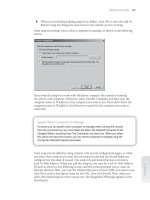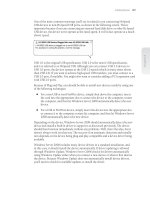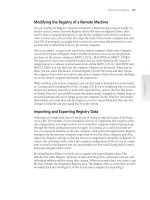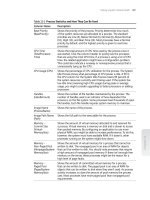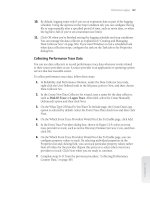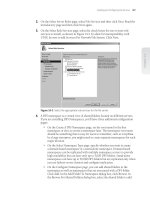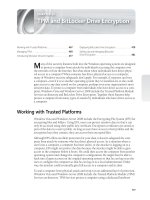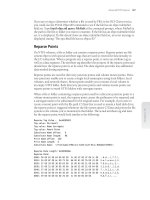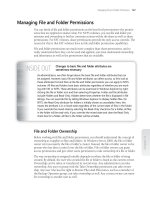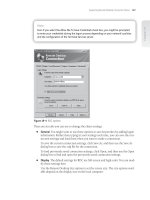Tài liệu Windows Server 2008 Inside Out- P30 pdf
Bạn đang xem bản rút gọn của tài liệu. Xem và tải ngay bản đầy đủ của tài liệu tại đây (704.24 KB, 50 trang )
on the system recently. A new device driver might have been installed or an application
might have been installed that incorrectly modifi ed the system confi guration.
Often you can resolve startup issues using Safe Mode to recover or troubleshoot system
problems. In Safe Mode, Windows Server 2008 loads only basic fi les, services, and driv-
ers. Because Safe Mode loads a limited set of confi guration information, it can help you
troubleshoot problems. You start a system in Safe Mode by completing the following
steps:
1. If the system is currently running and you want to troubleshoot startup, shut
down the server, and then start it again. If the system is already powered down or
has previously failed to start, start the server again.
2. Press F8 during startup to access the Windows Advanced Options menu. You
must press F8 before the Windows splash screen appears.
3. On the Windows Advanced Options menu, select a startup mode. The key
options are as follows:
Safe Mode—Starts the computer and loads only basic fi les, services, and
drivers during the initialization sequence. The drivers loaded include the
mouse, monitor, keyboard, mass storage, and base video. No networking
services or drivers are started.
Safe Mode With Command Prompt—Starts the computer and loads only basic
fi les, services, and drivers, and then starts a command prompt instead of
the Windows Server 2008 graphical interface. No networking services or
drivers are started.
Safe Mode With Networking—Starts the computer and loads only basic
fi les, services, and drivers, and the services and drivers needed to start
networking.
Enable Boot Logging—Starts the computer with boot logging enabled, which
allows you to create a record of all startup events in a boot log.
Enable Low Resolution Video—Starts the computer in low resolution 640×480
display mode, which is useful if the system display is set to a mode that
can’t be used with the current monitor.
Last Known Good Confi guration—Starts the computer in Safe Mode using Reg-
istry information that Windows Server 2008 saved at the last shutdown.
Debugging Mode—Starts the system in debugging mode, which is useful only
for troubleshooting operating system bugs.
Directory Services Recovery Mode—Starts the system in Safe Mode and allows
you to restore the directory service. This option is available on Windows
Server 2008 domain controllers.
Disable Automatic Restart On System Failure—Prevents Windows Server 2008
from automatically restarting after an operating system crash.
Troubleshooting Startup and Shutdown 1417
Chapter 41
Please purchase PDF Split-Merge on www.verypdf.com to remove this watermark.
Disable Driver Signature Enforcement—Starts the computer in Safe Mode with-
out enforcing digital signature policy settings for drivers. If a driver with
an invalid or missing digital signature is causing startup failure, this will
resolve the problem temporarily so that you can start the computer and
resolve the problem by either getting a new driver or changing the driver
signature enforcement settings.
4. If a problem doesn’t reappear when you start in Safe Mode, you can eliminate
the default settings and basic device drivers as possible causes. If a newly added
device or updated driver is causing problems, you can use Safe Mode to remove
the device or roll back the update.
5. Make other changes as necessary to resolve startup problems. If you are still
having a problem starting the system, you might need to uninstall recently
installed applications or devices to try to correct the problem.
Repairing Missing or Corrupted System Files
Windows Server 2008 enters Windows Error Recovery mode automatically if Windows
fails to start. In this mode, you have options similar to those you have when working
with the Advanced Boot menu. For troubleshooting, you can elect to boot the system
in Safe Mode, Safe Mode With Networking, or Safe Mode With Command Prompt.
You can also choose to use the Last Known Good Confi guration or to start Windows
normally.
If you can’t start or recover a system in Safe Mode, you can manually run Startup Repair
to try to force Windows Server 2008 to resolve the problem. To do this, complete the
following steps:
1. Insert the Windows installation or Windows Recovery disc for the hardware
architecture and then boot from the installation disc by pressing a key when
prompted. If the server does not allow you to boot from the installation disc, you
might need to change fi rmware options to allow booting from a CD/DVD-ROM
drive.
2. With a Windows Recovery disc, select Windows Setup (EMS Enabled) on
the Windows Boot Manager menu to start Windows Setup. With a Windows
installation disc, Windows Setup should start automatically.
3. On the Install Windows page, select the language, time, and keyboard layout
options that you want to use. Click Next.
4. When prompted, do not click Install Now. Instead, click the Repair Your
Computer link in the lower-left corner of the Install Windows page. This starts
the System Recovery Options wizard. If the boot manager is damaged, the wizard
will repair it at this point to obtain a list of available operating systems.
5. On the System Recovery Options page, click Command Prompt. At the command
prompt, enter cd recovery to access the X:\Sources\Recovery directory.
Chapter 41
1418 Chapter 41 Backup and Recovery
Please purchase PDF Split-Merge on www.verypdf.com to remove this watermark.
6. At the command prompt, enter startrep to run the Startup Repair wizard. Follow
the prompts to attempt to repair the server and enable startup.
Resolving Restart or Shutdown Issues
Normally, you can shut down Windows Server 2008 by clicking Start, and then click-
ing the Shutdown button, and restart Windows Server 2008 by clicking Start, pointing
to the Options button, and then clicking Restart. Sometimes, however, Windows Server
2008 won’t shut down or restart normally and you are forced to take additional actions.
In those cases, follow these steps:
1. Press Ctrl+Alt+Delete. The Windows Security screen should be displayed. If the
Windows Security screen doesn’t appear, skip to step 4.
2. Click Task Manager, and then look for an application that is not responding. If all
programs appear to be running normally, skip to step 4.
3. Select the application that is not responding, and then click End Task. If the
application fails to respond to the request, you’ll see a prompt that allows you to
end the application immediately or cancel the end task request. Click End Now.
4. Try shutting down or restarting the computer. Press Ctrl+Alt+Delete, and then
click the Shutdown button. As a last resort, you might be forced to perform a hard
shutdown by holding down the power button or unplugging the computer. If you
do this, run Check Disk the next time you start the computer to check for errors
and problems that may have been caused by the hard shutdown.
Troubleshooting Startup and Shutdown 1419
Chapter 41
Please purchase PDF Split-Merge on www.verypdf.com to remove this watermark.
Topic Description Page
Active Directory schema You cannot change an attribute even though you are a
member of the Administrators group
1016
Defragmenting disks Be careful when defragmenting 592
Drag and drop I’m unable to drag and drop items 135
Dynamic disks Dynamic disks have limitations 430
Hardware confi guration RAM and CPUs are incompatible 99
Hardware interrupts Check the device slot confi guration 241
Joining computer to domain The computer won’t join the domain 1227
Network interface Get separate views of bytes received and sent for
troubleshooting
323
Network interface performance Compare network activity to disk time and processor time 363
Network user class Class ID problems 726
Printer spooling Check permissions on the spool folder 881
Clear out stuck documents 909
Running out of space may indicate a deeper problem 913
Processor performance Rule out processor affi nity as an issue on multiprocessor
systems
359
Remote monitoring Try the IP address if you can’t connect 355
Shadow copy Shadow copy relies on the Task Scheduler 596
Shortcut menus No shortcut menus appear when I right-click 135
Storage area networks Detecting SAN confi guration problems 410
System processes Isolate 32-bit or 64-bit processes 315
Virtual memory Be careful when setting or moving the paging fi le 308
WINS replication Resolving WINS replication errors 828
Index to Troubleshooting Topics
Please purchase PDF Split-Merge on www.verypdf.com to remove this watermark.
Index
Symbols and Numbers
.NET Framework 3.0, 188
64-bit computing, 7–8. See also Itanium-based servers
A
access control
access permissions for fi les and folders, 571–578
Active Directory related features, list of, 989–990
entries. See ACEs (access control entries)
lists. See ACLs (access control lists)
systems, physical, 1315
user account control. See UAC (User Account Control)
account policies. See also Group Policy
Account Policies, editing with default GPOs,
1247–1249
confi guring user policies, 1169–1170
Group Policy objects. See GPOs (Group Policy objects)
Kerberos policy settings, 1169, 1173
local user accounts, 1169
location of, 1169
lockout policy, 1172, 1247
password policy enforcement, 1170–1171
password settings object creation, 1173–1176
accounts
Accounts: Rename Administrator Account policy, 1248
Accounts: Rename Guest Account policy, 1248
Administrator. See Administrator account
authentication of. See authentication
built-in capabilities of, 1178
contact accounts, 1168
creating user accounts, 1184–1187
default user accounts, 1168
domain. See domain user accounts
expiration options for, 1192
Guest account, 1168
InetOrgPerson. See InetOrgPerson accounts
local. See local user accounts
membership in groups, 1178
naming accounts, 1168
OUs, placing in, 1136
permissions of. See permissions
policies for. See account policies
RODC password replication policies, 1148, 1158–1159
user. See user accounts
user account control. See UAC (User Account Control)
ACEs (access control entries), 1188
ACLs (access control lists)
Active Directory, role in, 988
RODCs, for, 1158
ACPI (Advanced Confi guration and Power Interface),
379–382
ACPI BIOS, 240–241
Act As Part Of The Operating System privilege, 1178
activation of Windows Server 2008
process for, 88–90
viewing status of, 126–127
Active Directory
administering. See Active Directory Users And
Computers snap-in
architecture of. See Active Directory architecture
attribute management, 1014–1016, 1076
authoritative restores of, 1412–1414
backup strategies for, 1409–1410
backups for installation media creation, 1127–1128
bridgehead servers role, 58. See also bridgehead
servers
building blocks, logical, 1053
business requirements for, 1053–1054
changing structure of, 1061–1062
classes of objects, 1014
client connection requirements, 1111
compatibility issues, 1016–1020
Computer objects, 1014
confi guration containers in a forest, 1055
Contact objects, 1014
counters for, 1303–1304
CPUs, requirements for, 1108
creating domain controllers for existing domains,
1114–1122
data store architecture, 995–997
delegation of administrative rights, 1064–1065,
1136–1139
designing systems of. See Active Directory system
design
DHCP authorization, 689
DHCP set up with, 696, 698, 701
1421
Please purchase PDF Split-Merge on www.verypdf.com to remove this watermark.
Active Directory, continued
Directory Services log, 328
DNs (distinguished names), 1003–1004
DNS zones, Active Directory–integrated type, 752–755
domain architecture design for, 50
Domain objects, 1014
Domain Rename utility, 1061–1062
domain trees. See trees, Active Directory
domain trust design, 55
domains. See domains, Active Directory
failed domain controllers, removing references to,
1415–1416
failover clustering, confi guration for, 1351
forests. See forests, Active Directory
functional levels, 1016–1020
global catalog server role, 58. See also global catalog
servers
Group objects, 1014
group policy. See Group Policy
InetOrgPerson objects, 1014, 1063
infrastructure masters, 57
inheritance of permissions, 1137
installing. See installing Active Directory
installing DNS Server service with, 767–771
KCCs. See KCC (knowledge consistency checker)
links. See site links
LSA (Local Security Authority), 988–989
managing. See Active Directory Users And Computers
snap-in
media, installing from, 1126–1129
memory requirements, 1108
namespace design, 54–55
nonauthoritative restores of, 1411–1412
operations master role, 57. See also operations masters
OS support issues, 1016–1018
OUs. See OUs (organizational units)
PDC emulators, 57
Performance Monitor counters for, 1303–1304
planning deployments, 54–58
PrintQueue objects, 1014
read-only domain controllers. See RODCs (read-only
domain controllers)
recovery on SANs, 1110–1111
RID masters, 57
RODCs. See RODCs (read-only domain controllers)
Schema snap-in, 1047
Server objects, 1014
server roles, planning for, 57–58
share information, publishing, 552
site concept, 58. See also sites, Active Directory
Site objects, 1014
snap-ins, 163
Subnet objects, 1014
System State fi les, 1110–1111, 1129
system volume. See Sysvol
Sysvol replication, 1077–1082. See also Sysvol
SYSVOL$ shares, 555
task delegation, 1138–1139
tools for administering, table of, 107
transactional processing, 993–995, 1076
trees. See trees, Active Directory
troubleshooting trust relationships, 1039–1040
trust relationships. See trusts
uninstalling, 1129–1133
User objects, 1014
Windows Vista with, 10–11
Active Directory architecture
ACLs, 988
administrator types, 1002
attributes of objects, 998
authentication mechanisms, list of, 989
authentication procedure, 990
Checkpoint fi le, 995
common names of objects, 1003
Confi guration containers, 1004
containers, 998
data fi le types, 995–996
data store architecture, 995–997
Database Layer, 992–993
directory service component, 990–993
directory trees, 999–1000
DNs (distinguished names), 1003–1004
domains, 999, 1004. See also domains, Active Directory
ESE (Extensible Storage Engine), 993–995, 997
external trusts, 1003
Forest Root Domain containers, 1004
forests, 1000–1001. See also forests, Active Directory
global catalog servers, 1006
group policy, role of, 988
GUIDs, 992
indexed tables, 996
LDAP, 991, 998–999
log fi les, 995–997
logical architecture overview, 997–998
logon/access features used with, 989–990
MAPI, 992
multimaster approach to replication, 991–992, 1085
names of objects in data store, 992
NET LOGON, 989
object class types, 998
objects, 988, 998–999
operations masters. See operations masters
1422 Active Directory architecture
Please purchase PDF Split-Merge on www.verypdf.com to remove this watermark.
OUs. See OUs (organizational units)
partitions, 1005–1006
physical layer overview, 987–988
primary data fi les, 995–997
purpose of Active Directory, 987
RDNs, 1003
replication support, 991–993
RODC design considerations, 1145–1148
root domains, 1000, 1003–1004
rootDSE objects, 1003–1004
SAM with, 990, 992
Schema containers, 1004
schemas, 993, 998–999, 1055
security descriptor tables, 996
security subsystem key areas, 989–990
security subsystem, relation to, 987
shortcut trusts, 1003
SIDs (security identifi ers), 993
sites. See sites, Active Directory
Temporary data fi les, 995
tombstoned objects, 994–995
top-level view of, 987–988
transaction logs, 994
trust paths, 1002–1003
trust relationships, 988, 1001–1003
user mode, 987
Windows NT 4 with, 992
Active Directory Domain Services Installation Wizard.
See installing Active Directory
Active Directory Domains And Trusts tool
creating trusts with, 1035–1038
raising functional levels, 1019–1020
Trust Type property, 1034
UPN suffi xes, adding, 1021
validating trust relationships, 1039–1040
viewing existing trusts, 1033–1035
Active Directory Migration Tool. See ADMT (Active
Directory Migration Tool)
Active Directory Schema snap-in, 1047
Active Directory Sites And Services
bridgehead servers, confi guring as preferred,
1300–1301
changing forest connected to, 1284
creating sites, 1283–1285
domain controllers, associating with sites, 1286–1287
global catalog server designation, 1012–1013
site link bridges, confi guring, 1295–1297
site link creation, 1289–1292
starting, 1012
subnet creation, 1285
subnets, associating with, 1285–1286
universal group membership caching, 1021–1022
Active Directory system design
attribute management, 1014–1016
authentication design overview, 1020
building blocks for, 1053
business requirements for, 1053–1054
compatibility issues, 1016–1020
cross-forest transitive trusts, 1030–1032
delegating authentication, 1040–1043
domain functional level, 1016–1018
domain planning overview, 1058–1059
elements of, 1007
Exchange Server 2007 with, 1014
federated forest design, 1030–1032
forest function level, 1018–1020
forests. See forests, Active Directory
global catalog access, 1011–1013
Kerberos for authentication, 1023–1026
LDAP, 1010
multimaster replication model, 1008
NTLM (NT LAN Manager), 1023–1024
operations masters. See operations masters
OS support issues, 1016–1018
OUs. See OUs (organizational units)
planning overview, 1007–1008, 1053–1054
read-only domain controllers, 1008
relative names of objects, 1010–1011
replication attribute designation, 1014–1016
replication design, 1008–1009. See also replication
resource access process, 1025–1026
RODC design considerations, 1145–1148
security tokens, 1020–1022
session tickets, 1025–1026
shortcut trusts, 1028–1029
single vs. multiple domains, 1060–1061
single vs. multiple forests, 1056–1057
sites. See sites, Active Directory
trees, searching, 1010–1011. See also trees, Active
Directory
trusts. See trusts
two-way transitive trusts, 1027–1028
universal groups, 1020–1022
UPNs (user principal names), 1021
Windows Server 2008 domain functional level
features, 1018
writable domain controllers, 1008
Active Directory Users And Computers snap-in
account options, managing, 1189–1192
adding members to groups, 1222
administration, delegation of, 1137–1139
computer account management, 1225–1231
computer account property confi guration, 1229–1230
creating computer accounts, 1225–1226
1423Active Directory Users And Computers snap-in
Please purchase PDF Split-Merge on www.verypdf.com to remove this watermark.
Active Directory Users And Computers snap-in, continued
creating domain user accounts, 1184–1187
creating groups, 1220
default accounts, listing, 1168
delegated authentication, 1041–1043
deleting computer accounts, 1228
disabling computer accounts, 1228
fi nding shared folders, 552
group properties, editing, 1223–1224
infrastructure master role, managing, 1050–1051
joining computers to domains, 1226–1227
managing computer accounts remotely, 1228
Member Of tab, 1188
moving computer accounts, 1227
moving groups, 1224
OU creation with, 1133–1134
Password Settings group creation, 1173–1176
PDC emulator role, managing, 1050
purpose of, 153
queries, saving, 1223
renaming groups, 1224
renaming user accounts, 1211–1212
resetting passwords for computer accounts, 1228–1229
resetting user account passwords, 1212–1213
RID (relative ID) role, managing, 1048–1050
RODC Password Application Policy, editing, 1160–1162
sending mail to groups, 1224
taskpad example, 174
unlocking user accounts, 1213–1214
user account properties, viewing and setting, 1187–1188
active partitions, 77, 429
Active/Active controller model, 411
AD CS (Active Directory Certifi cate Services), 186
AD DS (Active Directory Domain Services)
described, 186
installing, 1114. See also installing Active Directory
AD FS (Active Directory Federation Services), 186
AD LDS (Active Directory Lightweight Directory
Services), 186
AD RMS (Active Directory Rights Management Services),
186
Add Features Wizard
starting, 114
Windows Server Backup, installing, 1388
Add Hardware Wizard, 235–236
Add Roles Wizard
RODC installations with, 1150
starting, 114
Terminal Services installation, 936–938
Add Workstations To Domain privilege, 1178
Add/Remote Programs utility, 285–286
address classes. See classes of networks
Address toolbar, 149–150
addresses, IP. See IP addresses
Adjust Memory Quotas For A Process privilege, 1178
Admin Approval Mode, 290–293
ADMIN$ shares, 554
administration
Active Directory, of. See Active Directory Users And
Computers snap-in
delegation of administrative rights using OUs,
1064–1065
delegation of, for Active Directory objects, 1136–1139
planning deployments, 51–54
planning, reviewing for, 42–43
remote. See Remote Desktop for Administration
tools for. See administration tools
tools, legacy compatibility issues, 52
administration tools
Active Directory tools, 107
Administrative Tools menu, 106–110
availability of, 109
Certifi cation Authority tool, 107
command-line utilities, 110–111
Computer Management console, 115–116
computer specifi cation for, 109
Control Panel utilities. See Control Panel
Data Sources (ODBC) tool, 107
DFS Management tool, 107
Event Viewer tool, 107
Failover Cluster Management tool, 107
File Server Resource Manager tool, 107
Initial Confi guration Tasks console, 113–114
installing, 109–110
installing full tool set, 160–161
Net tools, 111–112
Network Policy Server tool, 108
overview of, 105–106
PowerShell, 112–113
Registry, effect of tools on, 248
Reliability And Performance Monitor, 108
Server Manager. See Server Manager console
Services tool, 108
Storage Explorer, 108
System console, 126–128
administrative shares, 553–555
Administrative Templates, Group Policy, 1235
Administrative Tools menu, 385–388
Administrator account
Accounts: Rename Administrator Account policy, 1248
defi ned, 1168
renaming, 1168
strong passwords recommended, 88
administrator applications, 295
1424 active partitions
Please purchase PDF Split-Merge on www.verypdf.com to remove this watermark.
administrator tokens
application integrity, assuring
defi ned, 247
administrators
domain, 1002
enterprise, 1002
forests, roles in, 1055
Administrators group
default logon rights assigned to, table of, 1181–1182
default privileges assigned to, table of, 1178–1181
roaming user profi les, adding to, 1197
ADMT (Active Directory Migration Tool), 1061
ADMX fi les, 1237–1238
Advanced Boot Options menu, 383
advantages of Windows Server 2008, 3–4
aliases, DNS, 797–798
Allowed RODC Password Replication group, 1159–1160
alternate IP addressing, 660, 663–665
AMD-V, 10
analysis of preexisting system for deployment planning
assessing servers and services, 39
disaster recovery, 43–44
hardware inventories, 39–40
licenses, 39
localization issues, 39
network administration review, 42–43
network infrastructure evaluation, 38
network management tools, assessing, 44
network map creation, 38
network services and applications identifi cation, 40–41
project worksheets, 37
purpose of, 37
remote locations, 38
security infrastructure, 41–42
storage, 39
task in planning sequence, 29
answer fi les
purpose of, 70
specifying in Setup, 70
APIPA (Automatic Private IP Addressing)
troubleshooting, 676–677
use with DHCP, 665
Appearance And Personalization console, 120–122
application integrity
administrator applications, 295
administrator user tokens
Application Information service, 294
compliant applications, 294
integrity levels, 297
legacy applications, 294
overview, 294
run levels, 296–299
security settings related to, 299–301
standard user tokens, 294
UAC role in, 294
user applications, 295
Application log, 327
application servers
Application Server, 186
defi ned, 60
applications
high-availability guidelines for, 1309–1311
installing. See software installation
monitoring with Task Manager, 314
RemoteApps, making programs available as. See
RemoteApps
run levels, security tokens for, 247
running on remote servers. See Terminal Ser v ices
settings, storage of, 247
startup problems from, 388
Terminal Services compatibility scripts, 942
Terminal Services, installing, 939–943
virtualization, security tokens for, 247
Applications and Services logs, 327–328
Apply Group Policy permission, 1259–1261
architecture of Windows Server 2008
boot environment, 13–14
DNS design, 762–765
kernel architecture, 11–13
Network Diagnostics Framework, 15–18
support architecture, 14–25
architecture, Active Directory. See Active Directory
architecture
architecture, network
domain architecture, 50
team for planning, 31
archives
archive attribute, 1385
media rotation, 1386–1387
media types supported, 1387
atomic permissions, 575
attributes
Active Directory architecture object attributes, 998
fi le and folder, 567
multi-valued directory attributes, 1159
nonresident NTFS attributes, 504
OUs attributes, editing, 1135
Read Attributes special permission, 573
Read Extended Attributes special permission, 574
resident NTFS attributes, 503
Write Attributes special permission, fi le sharing, 574
1425attributes
Please purchase PDF Split-Merge on www.verypdf.com to remove this watermark.
auditing
fi le and folder access, 581–585
logging, DHCP, 727–729
printer access, 884
Registry access, 283–284
Security log, 327
systemic procedures for, 1319–1320
Terminal Services access, 964–966
Authenticated Users group
default logon rights assigned to, table of, 1181
default privileges assigned to, table of, 1178
authentication
Active Directory related mechanisms, list of, 989
computer accounts, troubleshooting, 1230–1231
cross-forest transitive trusts, 1030–1032
delegation overview, 1040–1041. See also delegating
authentication
design overview, 1020
forwarded tickets, 1040
Kerberos for, 1023–1026
NTLM (NT LAN Manager), 1023–1024
outgoing trust authentication levels, 1038
proxy tickets, 1040
RODC process for, 1144–1145
security token generation, 1020–1022
session tickets, KDC server, 1025–1026
session tickets, Kerberos policy settings, 1173
Terminal Services, for, 937
trust paths, 1002–1003
trusts. See trusts
universal group membership caching, 1020–1022
authoritative restores of Active Directory, 1412–1414
Automatic Black Hole Router Detection, 631
Automatic Dead Gateway Retry, 631
Automatic Updates, 11
availability
99.9 percent uptime goal, 1309
application requirements for, 1310
checklist for application deployments, 1311
clustering servers to improve. See clusters, server
facilities design. See structures and facilities
failover capabilities. See failover clustering
fault tolerance for, 1312. See also fault tolerance
hardware deployment process, 1312
hardware planning checklists, 1313
hardware standardization for high availability,
1311–1312
hardware strategy for, 1311–1313
high, defi ned, 1309
highly available server deployment, 1321–1322
integrated testing of applications for, 1310
noncritical system goals, 1309
operational plan for. See operations management
power supply redundancy, 1314
predeployment planning checklist, 1322
redundancy, components for improving, 1312
server types, standardization by, 1312
spare parts, 1312
standardized components for system services, 1310
standardized deployment process, 1310
standby systems, 1312
B
backups
Active Directory backup procedure, 1409–1410
Active Directory requirements, 1110–1111
archive attribute, 1385
Back Up Files And Directories privilege, 1178
command-line tools for, 1387
confi guring backup type, 1389
copy backups, 1385
daily backups, 1385
data considerations, 1382–1383
destination selection, 1398
DHCP backups, 1384
differential backups, 1385–1386
disaster preparedness procedures, 1373–1374
disaster preparedness, relation to, 1384. See also disaster
planning
DNS backups, 1384
DVDs for, 1390
event logs for, 1400–1401
fi le server backups, 1384
group membership required for, 1388
Group Policy backups, 1278–1280, 1384
importance of, 1381
incremental backups, 1385–1386
installing Windows Server Backup, 1388
manual backups, 1396–1400
media rotation, 1386–1387
normal backups, 1385–1386
one-time backups, 1396–1400
optimal technique selection, 1383–1385
plans for, 1318–1319
print server, 912–913, 1384
programs for, 1384, 1388
recommended strategy for, 1383
recovering data. See recovery
Registries, 272
scheduling, 1391–1395
services, backup functions of, 1383–1384
Shadow Copy API advantages for, 1383
starting Windows Server Backup, 1388
storage location selection, 1390
strategy considerations, 1382–1383
strategy creation questions, 1381–1382
1426 auditing
Please purchase PDF Split-Merge on www.verypdf.com to remove this watermark.
system fi le considerations, 1382–1383
volume specifi cation for, 1390–1391
VSS for fi le servers, 1384. See also VSS (Volume Shadow
Copy Service)
Wbadmin command, 1387, 1390
Windows Firewall settings for, 1390
Windows Server Backup feature, 190
Windows Server Backup overview, 1387
WINS backups, 1384
baselines for performance, establishing, 344
basic disks
compared with dynamic type, 428–430
conversions to and from dynamic type, 430–432
ESP partition type, 449–450
LDM partitions, 451–452
managing GPT partitions on, 449–452
managing MBR partitions, 434–448
MSR partitions, 450–451
OEM partitions, 452
primary partitions, 451
basic folder permissions, table of, 572
BCD (Boot Confi guration Data) stores
boot sequence, temporarily changing, 404
commands, table of, 389–390
creating entries, 394–395
creating new, 393–394
Debugger Settings entries, 397
default operating system entry selection, 403
deleting entries, 395
deleting options, 395–396
DEP (Data Execution Prevention) options, 402
Editor, 388–390
EMS Settings entries, 396–397
entries in, 388
exporting, 394
guidelines for modifying, 390
GUIDs with, 392
Hypervisor Settings entries, 397
importing, 394
multiple operating systems with, 393
operating system display order, 402–403
options for boot application entries, 399
options for Windows OS Loader applications, 400–401
PAE mode options, 402
properties, table of, 391
purpose of, 382–383
registry for, 382
Resume from Hibernate entries, 396
sample listing, 390–391
setting entry values, 395
system BCD stores, 390
timeout default, setting, 404
viewing entries, 390–393, 396–397
well-known identifi ers, 392
Windows Legacy OS Loader entries, 396
Windows Memory Tester entries, 396
BIOS (basic input/output system)
ACPI requirement, 379
entering during boots, 380
legacy boots, 382
BirthObjectIDs, 516
BirthVolumeIDs, 516
BitLocker Drive Encryption
boot fi le validation, 477
boot issues, 382
data volume encryption, 493–494
decrypting data volumes, 495
defi ned, 188
deploying, 478–480
disabling, 495
Drive Preparation Tool, 484–485
enabling encryption with PINs, 491
enabling encryption with startup keys, 488–491
FIPS, 481
installing, 485
keys for volumes, 481
listing encrypted volumes, 492
non-TPM operation of, 477–478
partitions for, 479–480, 482–485
password management, 492–493
performance issues, 477
PIN management, 492–493
PINs, role of, 491–492
planning for, 479
policy settings for, 480–481, 486–487
purpose of, 11, 477
readiness test, 485–486
recovering data, 494–495
Recovery mode, 477–478
recovery passwords, 487–488
remote administration issues, 478
setup steps, overview, 481–482
Startup Key Only mode, 478
startup keys, 488–491
system vs. data volume encryption, 481
TPM and PIN mode, 478
TPM and Startup Key mode, 478
TPM with, 468, 477–478
TPM-Only mode, 478
USB fl ash startup keys, 478
Windows Vista vs. Windows Server 2008 versions, 479
BITS (Background Intelligent Transfer Service) Server
Extensions, 188
1427BITS (Background Intelligent Transfer Service) Server Extensions
Please purchase PDF Split-Merge on www.verypdf.com to remove this watermark.
boot confi guration
ACPI requirement, 379
Advanced Boot Options menu, 383
applications problems, 388
BCD stores. See BCD (Boot Confi guration Data) stores
BIOS legacy boots, 382
BitLocker boots, 382
boot environment layer, 382–383
boot loader applications, list of, 388
boot sequence, temporarily changing, 404
CPUs, specifying number to use, 386
DEP (Data Execution Prevention) options, 402
desktop class system issues, 377
EFI legacy boots, 382
fi rmware boot settings, 381–382
fi rmware types, 379
fi rmware, entering during boots, 380
hardware capabilities, 379–382
memory, specifying amount to use, 386
msconfi g.exe command, 385–388
No GUI boots, 386
overview, 13–14, 377
partition styles, 382
power settings in fi rmware, 380–381
power state management capabilities, 379–382
power state options, 379–380
Safe Boot modes, 386
SANs, booting from, 409–411
services problems, 387
Startup And Recovery dialog box, 384–385
startup control within boot environment, 382–383
startup issues compounded in 2008, 377
Startup Repair Tool, 1408–1409
System Confi guration, 385–388
timeout default, setting, 404
TPM for boot fi le validation, 468
Windows Boot Loader, 383
Windows Boot Manager, 383
Windows Vista power state management, 378
boot partitions
defi ned, 77
mirrored boot volumes, 459–462
system partition allowed with, 429
BOOTP (Bootstrap Protocol), 685
bottlenecks
disk I/O, 360–362
memory, 356–358
network-based, 362–363
overview of, 356
bridgehead servers
confi guring, 1298–1301
defi ned, 58
intersite replication with, 1089–1091
listing for sites, 1298
multiple, 1094–1095
preferred servers, 1299–1301
replication attribute options, 1305–1306
RODCs not allowed as, 1145
site links, relationship to, 1287
sites, role in, 1072
testing replication, 1305–1306
bridges, 639
broadcast IP addresses, 636–637
budget issues, 47–48
building phase of MSF (Microsoft Solutions
Framework), 28
business requirements
Active Directory planning for, 1053–1054
goal assessment task for planning deployments, 34–35
organizational objectives, specifying, 45–46
system availability. See availability
business units as OUs (organizational units), 1066
Bypass Traverse Checking privilege, 1178
C
C$ type drive shares, 554
cabling, 1314
CALs (client access licenses)
CAL Installation Wizard, Terminal Services, 954–957
defi ned, 63
per-server vs. per-user options, 71
Terminal Services with, 925–927
CAPI2 (CryptoAPI version 2), 18
certifi cates
Certifi cation Authority tool, 107
OCSP (Online Certifi cate Status Protocol), 18
change control procedures, 1317–1318
change journals, 514–515
change logs, 1317
change management planning process, 54
Change Permissions
fi le sharing, 564
fi le special permission, 575
printer permission, 880
Change The System Time privilege, 1179
Change The Time Zone privilege, 1179
Check Disk tool
bad sectors, marking, 540
command-line parameters, table of, 537–538
dirty, marking disks as, 537
FAT volumes, analyzing, 538–539
fi xing errors with, 535–537
NTFS volumes, analyzing, 539–540
repairing volumes, 540
Self Healing NTFS alternative to, 520–521
syntax for, command line, 537
1428 boot configuration
Please purchase PDF Split-Merge on www.verypdf.com to remove this watermark.
child domains, 653
child folders, 569
CIDR (classless interdomain routing)
nonclassful network nature of, 637
notation, 640–641
classes of networks
class A network subnets, 642–644
class B network subnets, 644–645
class C network subnets, 645–646
IDs for, 638–639
purpose of, 633–635
clean installations
Initial Confi guration Tasks console, 87
installation step, 87
language selection, 86
product keys, 85–86
rolling back installations, 84
starting, 84
steps for, 84–88
updates during, 85
where to install to, choosing, 86–87
client access licenses. See CALs (client access licenses)
cluster-aware applications
failover clustering of, 1348
high-availability goals for, 1309–1310
redundancy role of clustered systems, 1312
service compatibility requirements, 1325
clusters, fi le system
FAT, 500
fi le system overview, 498–499
NTFS, 508
clusters, server
active nodes, 1327–1328
application software compatibility with. See cluster-
aware applications
availability goal of, 1324
benefi ts of, 1324–1325
Cluster Administrator renamed, 1352
Cluster service, 1352–1353
failover function. See failover clustering
failures, causes of, 1324
farms, 1325
fault tolerance not provided by, 1324
high availability, 1323–1324
load balancing. See NLB (Network Load Balancing)
maximum number of nodes supported, 1326
multisite options, 1329–1330
nodes defi ned, 1323
operating modes, 1327–1328
operating system version differences for, 1326
organization of servers in, 1325–1326
packs, 1325–1326
passive nodes, 1327–1328
print drivers with, 846
purpose of, 1324
quorums, 1330
redundancy role of, 1312
reliability goals, 1324–1325
SANs using, 409–411
scalability goals, 1325
scalability limits, 1326
server clusters defi ned, 1323–1324
shadow copy issues, 595
three-tier structure for, 1326
CMAK (Connection Manager Administration Kit), 188
color printers
basics of, 851
profi les, confi guring, 906–907
color scheme selection, 120–121
command-line utilities, list of, 110–111
Compact command, 523
compliant applications, 294
Compound TCP, 631
compressed (zipped) folders, 524–525
computer accounts
authentication issues, 1230–1231
Computer container, 1225
computer name, viewing, 1229
creating, 1225–1226
delegated authentication, 1042–1043, 1229
deleting, 1228
dial-in settings, 1230
disabling, 1228
Effective Permissions tool, 1188–1189
group membership confi guration, 1229
group policies for. See Group Policy
joining computers to domains, 1226–1227
Managed By property, 1229
managing remotely, 1228
moving, 1227
properties, confi guring, 1229–1230
remote install option, 1230
resetting passwords, 1228–1229
security options, advanced, 1230
troubleshooting, 1230–1231
user object canonical name, 1229
Computer Management console
components of, 115
Computer Management Services And Applications
tools, 116
Computer Management Storage tools, 116
Computer Management System Tools, 115–116
creating shares with, 559–562
fi le sharing, 556
MMC nature of, 155
offl ine fi les confi guration, 1207–1208
1429Computer Management console
Please purchase PDF Split-Merge on www.verypdf.com to remove this watermark.
Computer Management console, continued
publishing shares, 563
remote device management, 221
shadow copy confi guration, 593–596
share permission confi guration, 565–566
TS Session Broker authorization, 946–947
computer names
Append Suffi xes settings, 667–668
changing, 127
viewing, 117, 126
WINS for resolving, 654–655
conditional forwarding, DNS
benefi ts of, 754
confi guring, 786–788
drawbacks of, 756
purpose of, 748
confi guration tools. See administration tools
Confi gure A DNS Server Wizard, 773–783
confi guring TCP/IP networking
alternate IP addressing, 660, 663–665
DNS confi guration, 667–669
dynamic IP addressing, 660, 663–665
IP address confi guration methods, 660–661
IP address information needed, 657–658
multiple gateway confi guration, 665–666
overview of, 660
static IP address assignment, 660–663
WINS confi guration, 669–671
confi guring Windows Server 2008. See also specifi c
confi guration topics
desktop confi guration, 142–143
menu customization. See menu system
overview of, 129
Quick Launch, 148–149
taskbar confi guration, 143–148
toolbar optimization, 148–151
confl ict detection of IP addresses, 734
consoles. See MMCs (Microsoft Management Consoles)
contact accounts, 1168
contingency allowances in planning projects, 48–49
Control Panel
Appearance And Personalization console, 120–122
color scheme selection, 120–121
Date and Time utility, 122–123
desktop background selection, 121
display settings for monitors, 122
Folder Options utility, 123–124
mouse pointer selection, 121
overview of utilities in, 106
Programs And Features page, 287–288
Regional and Language Options utility, 125
Registry, effect of tools on, 248
screen savers, 121
sound schemes, 121
themes, 121–122
Uninstall Or Change A Program utility, 273
views available, 119–120
copy backups, 1385
copying items, 135–136
core-server installation type, 80
counters
Active Directory counters, 1303–1304
adding to Performance Monitor, 349–350
alert confi guration, 369–370
counter list, 352
data collector sets of. See data collector sets
default, 349
defi ned, 346–347
deleting, 350
disk I/O, 360–362
display of, 350
graphing of statistics for, 351
Histogram Bar view, 353
memory, 357–358
Memory\Available Bytes, 357
Memory\Commit Limit, 357
Memory\Committed Bytes, 357
Memory\Page Faults/Sec, 357
Memory\Pages Input/Sec, 357
Memory\Pages Output/Sec, 357
Memory\Pages/Sec, 357
Memory\Pool Nonpaged Bytes, 358
Memory\Pool Paged Bytes, 358
network, 362–363
Paging File\% Usage, 358
Paging File\% Usage Peak, 358
Paste Counter List button, Performance Monitor, 352
performance objects, table of common, 348–349
Physical Disk\% Disk Time, 358
Physical Disk\Avg Disk Queue Length, 358
Physical Disk\Avg Disk Sec/Transfer, 358
PhysicalDisk\ counters, 361–362
print server, 909–912
Processor\% Privileged Time, 360
Processor\% Processor Time, 360
Processor\% User Time, 360
Processor\Interrupts/Sec, 360
remote monitoring of, 354–355
Report view, 353
sample rates, 351
System\Processor Queue Length, 360
CPUs (central processing units)
Active Directory requirements for, 1108
bottlenecks, resolving, 359–360
1430 computer names
Please purchase PDF Split-Merge on www.verypdf.com to remove this watermark.
counters for, 360
installation errors caused by, 98–99
Itanium. See Itanium-based servers
listing types of, 126
multiprocessor affi nity issues, 359
performance statistics in Reliability And Performance
Monitor, 345
performance statistics in Task Manager, 311–313
process usage of, 315
processor scheduling options, 304–305
requirements by edition, 72–73
specifying number to use, 386
WSRM (Windows System Resource Manager), 190
crash dump partitions, 77, 429
Create A Pagefi le privilege, 1179
Create A Shared Folder Wizard, 560–562
Create Files/Write Data special permission, 574
Create Folders/Append Data special permission, 574
Create privileges, 1179
credentials, logon, 1195
cross-forest transitive trusts, 1030–1032, 1035
D
daily backups, 1385
DAS (direct-attached storage), 405–406
data collector sets
alert confi guration, 369–370
capabilities of, 363
confi guration sets, 364, 368
creating, 365–367
deleting, 365
performance counter sets, 364–367
purpose of, 343, 363
Reliability And Performance Monitor console for,
363–364
reports, viewing, 368–369
saving as templates, 364
startup event traces, 364
trace data sets, 364, 367–368
types of, 364
Data Execution Prevention (DEP) options, 402
data packets. See packets
Data Sources (ODBC) tool, 107
data streams, 512–513
database server failover clustering, 1349–1351
Datacenter edition, Windows Server 2008
features of, 6
hardware requirements for installations, 72–73
selection criteria, 62–63
Date And Time utility, 122–123
day-to-day operations. See operations management
Dcgpofi x utility, 1282
Dcpromo command, 1112, 1114, 1129
Debug Programs privilege, 1179
Default Domain Controllers Policy GPO
purpose of, 1235
restoring defaults, 1282
Default Domain Policy GPO
purpose of, 1235
restoring defaults, 1282
defragmenting drives
confi guring automated, 541–542
Disk Defragmenter for, 543–544
fragmentation analysis, 545–546
fragmentation process, 541
shadow copy issues
delegating authentication
account option for, 1192
confi guring, 1041–1043
purpose of, 1040
ticket models for, 1040
delegating management tasks
defi ned, 1249
delegating Group Policy management privileges,
1252–1253
delegating privileges for links and RSoP, 1253
GPO creation rights, 1249–1250
reviewing Group Policy management privileges,
1250–1252
Delete special permission, 574
Delete Subfolders And Files special permission, 574
deleting user accounts, 1210–1211
Denied RODC Password Replication group, 1159–1160
DEP (Data Execution Prevention) options, 402
department based groups, 1217
deployments of applications
checklist for, 1311
standardized deployment process for high availability,
1310
deployments of hardware
highly available server deployment, 1321–1322
standard process checklist, 1312
deployments of Windows Server 2008
MSF deployment phase, 28
planning. See planning deployments
designing new networks
domain architecture, 50
network operations issues, 50–51
overall objectives for, 50
place in overall design plan, 30
security requirements, 51
Desktop Experience
defi ned, 12–13
purpose of, 188
recommended, 129
Software Explorer, 288
1431Desktop Experience
Please purchase PDF Split-Merge on www.verypdf.com to remove this watermark.
Desktop toolbar, 150
desktops, confi guring, 142–143
development teams, 32
Device Manager
confl icting devices, 240–243
driver installation steps, 230–232
drivers, viewing information about, 224
Enable Device command, 225
removing drivers, 234
Resources tabs for drivers, 227–228
rolling back drivers, 233
shortcut menu options, 220
troubleshooting with, 237–243
types of devices displayed, options for, 221
viewing devices with, 219–220
warning symbols, 220
devices. See also hardware
drivers for. See drivers
installing, 215–221
DFS (Distributed File System)
architecture of, 1081–1082
clustering with, 1363
DFS command-line tools, 409
DFS management tool, 107
Dfscmd tool, 409
Dfsdiag tool, 409
metatdata of, 1080
Namespaces, 415, 417– 418
optimizing File Services with, 415
purpose of, 408
Replication, 415
Replication log, 328
sites, Active Directory, effects on, 1073–1074
Sysvol replication, 1077–1082
DHCP (Dynamic Host Confi guration Protocol). See also
DHCP console
Active Directory authorization for, 689, 701
Active Directory, setting up with, 696, 698
APIPA, 665, 676–677
audit logging, 727–729
autoconfi guration routine, 687–688
availability, 693–695
backups of, 1384
client broadcasts, 689–690
clients per server guideline, 686
clustering with, 1363
confi guring network addresses, 663–665
confl ict detection with, 734
confl icting addresses, troubleshooting, 677
console. See DHCP console
database management, 735–737
defi ned, 685
DHCP Server, 186
DHCPv6 capable clients, 632, 687–688
DHCPv6 stateless mode, 698
Discover messages, 689–690
DNS confi guration with, 667, 686, 697, 730, 757
domain controller collocation issue, 689
dynamic addressing, 660
dynamic clients, 685
dynamic DNS with, 759–760
exclusions, 686, 709, 712–713
failover, 693–695
fault tolerance, 693–695
installing DHCP Server service, 697–700
IPCONFIG command for lease control, 680
IPv4 autoconfi guration, 687
IPv4 messages and relay agents, 689–691
IPv6 autoconfi guration, 687–688
IPv6 messages and relay agents, 691–693
lease audits, 728
lease broadcast process, 689–693
lease databases, 685
lease date stamps, viewing, 673
lease duration specifi cation, 705–706
lease renewal process, 679–680
leases defi ned, 660
limited broadcasts, 637
M and O fl ags, 691–693
management console. See DHCP console
message mechanics, 689–693
multiple gateway confi guration, 665
NAP integration, 731–733
Netsh DHCP command, 700
NICs, binding to server’s, 729
normal scope creation, 702–710
number of clients per server, 696
Offer messages, 689–690
planning issues, 60, 689–695
relay agents, 691–693, 737–742
renewing leases, 690–691
Request messages, 689–690
reservations, 686, 713–716, 718
restoring data, 737
Routing and Remote Access Services setup, 737–739
RRAS integration, 686–687
saving confi gurations of, 734–735
saving data, 737
scopes. See scopes for IP addresses
security issues, 688–689
server selection guidelines, 689, 696
servers, reservations recommended for, 686
setting up servers, overview of, 696–697
sites, requirements for, 1073
1432 Desktop toolbar
Please purchase PDF Split-Merge on www.verypdf.com to remove this watermark.
standby servers, 696
startup sequence for clients, 687
TCP/IP option confi guration. See TCP/IP options under
DHCP
troubleshooting, 679–680
user-defi ned classes, 724–726
WINS settings, 697
wireless network security issues, 689
workgroup setup with, 697
DHCP console
activation of scopes, 716
domain name specifi cation, 706
exclusions, 712–713
lease duration specifi cation, 705–706
normal IPv6 scope confi guration, 708–710
reservation management, 713–716
router address specifi cation, 706
scope creation, 702–705
starting, 699
WINS server specifi cation, 707
DHCPv6. See also DHCP (Dynamic Host Confi guration
Protocol)
clients, 632, 687–688
stateless mode, 698
diagnostics
key areas, table of, 20–21
Network Diagnostics Framework, 15–18
overview of, 14–15
startups, diagnostic, 385–388
WDI (Windows Diagnostics Infrastructure), 19–25
dial-in settings for computer accounts, 1230
differential backups, 1385–1386
direct-attached storage. See DAS (direct-attached storage)
directory. See Active Directory
directory partitions. See partitions, directory
Directory Replicator remote access to Registry
requirement, 282
directory service (Ntdsa.dll)
Active Directory with, 992–993
defi ned, 990
names of objects, 992
replication, role in, 993
schemas, 993
SIDs, reading, 993
Directory Services log, 328
Directory Systems Agent. See DSA (Directory Systems
Agent)
directory trees. See trees, Active Directory
disabling user accounts, 1193, 1195, 1211
disaster planning
availability issues. See availability
backup plans for data, 1370
backup procedures, 1373–1374
backups, coordinating with, 1384
emergency response teams, 1371
escalation procedures, 1372–1373
fault tolerance, 1370
identifi cation of essential systems, 1369–1370
incident response teams, 1371
Microsoft Product Support, 1375–1376
notifi cation procedures, 1372
On Screen Keyboard, 1377
overview of, 1369
physical security, 1370
post-action reporting, 1373
power protection plan, 1370–1371
preparedness procedures list, 1373
priorities systems, 1373
problem resolution policy documents, 1371–1373
recovery issues, 43–44, 1370
Rollback wizard, 1378
servers, types of essential, 1369
staff key data, 1372
Startup Repair, 1374–1375
UPS (uninterruptible power supplies), 1370–1371
vendor key data, 1372
Disk Defragmenter, 541–546. See also defragmenting
drives
disk drives. See hard disk drives; storage
disk I/O subsystem, 497
Disk Management snap-in
adding new disks, 423–424
bad sectors, marking, 438
Check Disk, starting, 536
command-line counterpart. See DiskPart tool
converting basic to dynamic disks, 431–432
converting dynamic to basic disks, 432
encrypted BitLocker volumes, 492
extending volumes, 443–446
moving dynamic disks, 456–457
purpose of, 419–420
quotas, setting, 529–532
rescanning disks, 455–456
shrinking partitions with, 446–447
spanned volume creation, 453–454
views available, 421
volume creation, 435–439
disk mirroring. See mirrored volumes
disk quotas. See quota management
disk striping. See striped volumes
DiskPart tool
converting disk types, 432
defi ned, 409, 421
extending volumes, 445–446
1433DiskPart tool
Please purchase PDF Split-Merge on www.verypdf.com to remove this watermark.
DiskPart tool, continued
invoking, 421
listing devices with, 422
sample session, 422
selecting devices, 422
shrinking partitions with, 447
Distributed File System. See DFS (Distributed File
System)
distribution groups, 1216
DLT (Distributed Link Tracking) Client, 516–517
DNs (distinguished names)
defi ned, 1003–1004
searching, 1010–1011
DNS (Domain Name System)
A records, 794–797
AAAA records, 794–797
Active Directory requirements, 1109–1110
Add Roles Wizard for installing services, 771
aging confi guration, 807–808, 818
aliases, 797–798
appending computer names settings, 667–668
application directory partitions, confi guring, 804–806
architecture for, 762–765
automatic record creation, 794
backups of, 1384
cache management, 813
canonical names, 748
client TCP/IP confi guration checks, 810–811
client/server nature of, 743
CNAME records, 797–798
conditional forwarding, 748, 754, 756, 786–788
confi guration fl ags, table of, 816–818
Confi gure A DNS Server Wizard, 773–783
confi guring settings, 667–669
database for, 746
defi ned, 743
destination caches, 683
DHCP-based confi guration, 667, 686, 697, 730, 757
DNS console, 771–772
DNS names for domains, setting, 768
Dnscmd /Info command, 813–814
Dnscmd /Statistics command, 818–819
Dnscmd command, 772
DNSSEC (DNS Security), 757–758
domain names, 653–654
dynamic updates, 668, 759–760, 776, 781–782, 819
event logging, 808–809
external name resolution security, 760–761
external resource requests, 747–748
forward lookup queries, 743
forward lookup zone creation, 774–781, 783–785
forwarders, 777–778, 782–783, 786–788, 818
global name deployment, 803–804
host addresses, 748
host names, 653
inappropriate associations, 757
installing DNS Server service with Active Directory,
767–771
installing DNS Server service without Active Directory,
771–773
IPv6 addresses for servers, 681, 756–757
ISP zone maintenance, 776
LLMNR with, 655–656
log confi guration, 808–809
lookups, troubleshooting with, 812
mail exchange addresses, 749
main components of, 746
MX (Mail Exchanger) records, 798–799
name resolution in, 654, 746–748
name server resource records, 749
namespace, Active Directory planning, 54–55
namespaces, 744–746
NS records, 794, 799–800
parameters, server confi guration, table of, 815–818
planning deployments of, 40, 59
planning overview, 744
pointer resource records, 749
preferred DNS server IP addresses, 773
primary DNS servers, 750–751, 771
primary zone creation, 775
private namespace, 746
PTR records, 794–797
purpose of, 652
query and reply, basic, 746–747
query security issues, 757–758
query statistics, 818–819
query types, 743
record change propagation, 795
recursion, 778, 786–788
registering clients, 809
replication scope, 780, 782
replication, troubleshooting, 813
resolver caches, 681–683, 811
resource records, 748–749, 794–802
restart issues, 754–755
reverse lookup queries, 743–744
reverse lookup zone creation, 781–782, 785–786
reverse lookup zones, 774
RODCs with, 1143, 1149
root hints fi les, 760–761, 778
roots name servers, 760–761
roots, namespace, 745
round-robin load balancing, 797, 1331
scavenging, 807–808
1434 Distributed File System
Please purchase PDF Split-Merge on www.verypdf.com to remove this watermark.
secondary DNS servers, 750
secondary notifi cation confi guration, 793–794
secondary zone creation, 775
secondary zone setup, 770–771
secure dynamic updates, 759–760
separate-name design, 763–765
server order, setting, 667
server TCP/IP confi guration checks, 812–813
service location resource records, 749
sites, requirements for, 1073
small network confi guration, 774–778
SOA records, 794, 800
split-brain design, 762–763
SRV records, 794, 801–802
start-of-authority resource records, 749
static, single label name confi guration, 803–804
subdomain confi guration, 788–791
testing, 682
top-level domains, 745–746
troubleshooting, 680–683
troubleshooting client services, 809–812
troubleshooting server services, 800–821
TTL values, 682
viewing server confi guration, 813–819
WINS lookups using, 839
zone transfers, 791–793
zones, 749–757
DNS Server. See also DNS (Domain Name System)
defi ned, 186
log, 328
documentation, importance of, 1317
domain administrators, 1002
domain controllers
authoritative restores of Active Directory, 1412–1414
backup media, creating from, 1127–1128
backup requirements, 1110–1111
change journals, 514
confi guration containers in a forest, 1055
creating domain controllers for existing domains,
1114–1122
Default Domain Controllers Policy GPO, 1235,
1247–1249
delegation of administrative rights, 1136–1139
deleting, 1129–1133
designing systems of. See Active Directory system
design
DHCP server collocation issue, 689
domain architecture design, 50
failed, removing references to, 1415–1416
global catalog access, 1011–1013
global catalog servers, 1006
hardware guidelines, 1108–1109
IP addresses, 1109
local account issues, 1113–1114
moving out of Domain Controllers OU, danger of, 1249
NETLOGON share, 555
nonauthoritative restores of Active Directory, 1411–1412
operations master. See operations masters
OS support issues, 1016–1018
OUs created within, 1133
partitions, 1005
planning issues, 58–59
privileges required for creating, 1112–1113
read-only. See RODCs (read-only domain controllers)
recovery strategies for, 1409–1410
replication issues. See replication
replication scope, 1008
replication topology based on number of, 1092
restoring failed with new, 1415–1416
restoring Sysvol data, 1414–1415
sites, associating with, 1286–1287
sites, locating in separate, advantages of, 1075
subdomain, DNS confi guration for, 788–791
SYSVOL$ shares, 555
trust paths, 1002–1003
domain functional levels
operations masters, 57
planning for, 55–57
purpose of, 1016
RODC level requirements, 1148
Sysvol replication, 1077–1082
table of, 1017
Windows 2000 native mode, 1017
Windows 2008 mode, 1018
Windows Server 2003 mode, 1017–1018
domain local groups
defi ned, 1217
local domain processing requirement, 1218
member inclusion rules, 1218
nesting limitations, 1218
permissions rules, 1218
reasons for using, 1218–1219
domain names
child domains, 653
defi ned, 653
fully qualifi ed, 654
obtaining, 653
parent domains, 653
resolving. See name resolution services
top-level domains, 653
domain naming master role, 1044–1046, 1048
Domain Rename utility, 1061–1062
domain trees, 1053. See also trees, Active Directory
domain trusts
confi guring, 1035
planning for, 55
1435domain trusts
Please purchase PDF Split-Merge on www.verypdf.com to remove this watermark.
domain user accounts
Administrator. See Administrator account
backing up passwords, 1214–1215
built-in capabilities of, 1178
cached credentials, 1195
consistency requirement, 1169
creating, 1184–1187
default user accounts, 1168
defi ned, 1167
deleting, 1210–1211
disabling, 1191, 1193, 1195, 1211
Effective Permissions tool, 1188–1189
enabling, 1211
enabling disabled, 1195
expiration options for, 1192
folder redirection, 1203–1207
group memberships of, 1177–1178
Home Folder, 1194
inheritance effects, 1188
Kerberos options, 1192
Kerberos policy settings, 1173
lockout policy, 1172, 1195
logon rights of, 1178
maintenance overview, 1210
moving, 1211
multiple users, selecting, 1211
naming accounts, 1168
options, managing, 1189–1192
password policy enforcement, 1170–1171
Password Settings containers, 1169
permissions of, 1178
policy confi guration, 1169–1170
privileges of, 1178
profi le settings, 1193–1194
properties, viewing and setting, 1187–1188
renaming, 1211–1212
resetting passwords, 1212–1213
security descriptors of, 1188
SIDs (security identifi ers) of, 1210
smart cards, requiring, 1192
top-level account policies, 1169
troubleshooting, 1195
unlocking, 1213–1214
user profi les. See user profi les
DomainIDs, 516
domains, Active Directory
assigning user rights for, 1182–1183
changing designs for, 1061–1062
creating new domains in new forests, 1122–1125
creating new domains or trees in existing forests,
1125–1126
creation in Active Directory, 1005
defi ned for Active Directory, 999, 1053
delegation of administrative rights, 1136–1139
deleting, 1129–1133
design considerations, 1059
domain functional level, 1016–1018
domain security policies, 1059
enforcing inheritance, 1258–1259
forests, relationship to, 1054–1055
group policies created with, 1235
group policies of. See Group Policy
group policy inheritance order, 1254
joining computer accounts to, 1226–1227
language standardization within, 1059
membership options, 83
OUs in. See OUs (organizational units)
planning overview, 1058–1059
policies on, 1059
privileges required for installing, 1112–1113
raising functional levels, 1019–1020
renaming, 1061–1062
replication considerations, 1059
resource access issues, 1059
root domains, 1000
servers for. See domain controllers
single vs. multiple, design considerations, 1060–1061
sites, relationship to, 1071
task delegation, 1138–1139
top-level domains, 653
trees. See trees, Active Directory
trusted and trusting, 1001–1002
DoS attacks, DHCP vulnerability to, 688
drive letters
assigning, 436
confi guring, 440–442
enumeration of, 435
drivers
adding print drivers, 888
base installation library of, 222
bugginess of, 211
Code Signing For Device Drivers policy, 224
detection of missing, automatic, 215
disabling, 236–237
improvements in, 19
installation steps, 230–232
installation wizards, 229–230
installing available updates, 215–216
kernel mode, 845
loading disk drivers during installation, 94–95
maintaining lists of, 228
manifest fi les, 222
Microsoft Universal Printer Driver, 846
network adapters, Advanced settings for, 227
1436 domain user accounts
Please purchase PDF Split-Merge on www.verypdf.com to remove this watermark.
